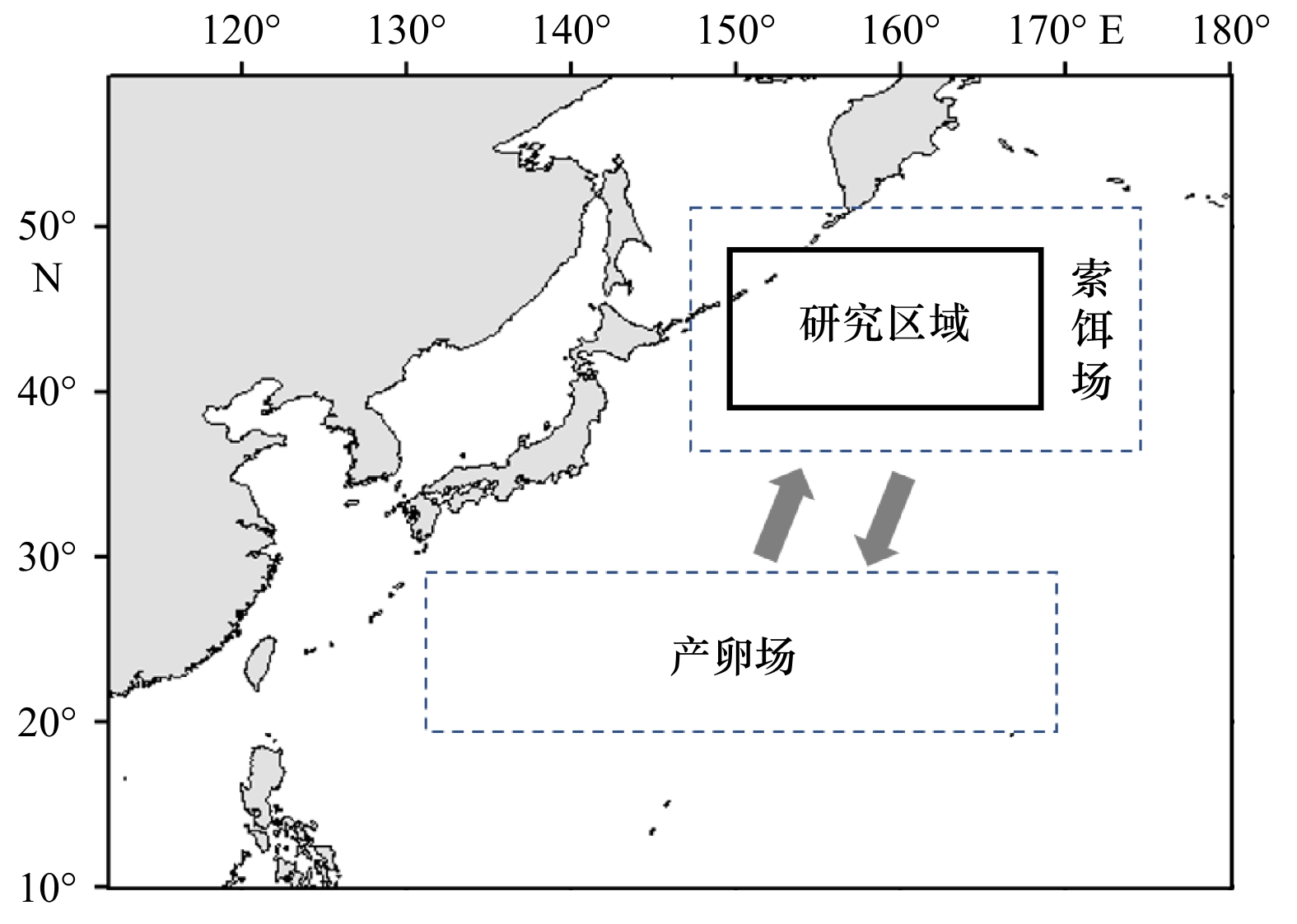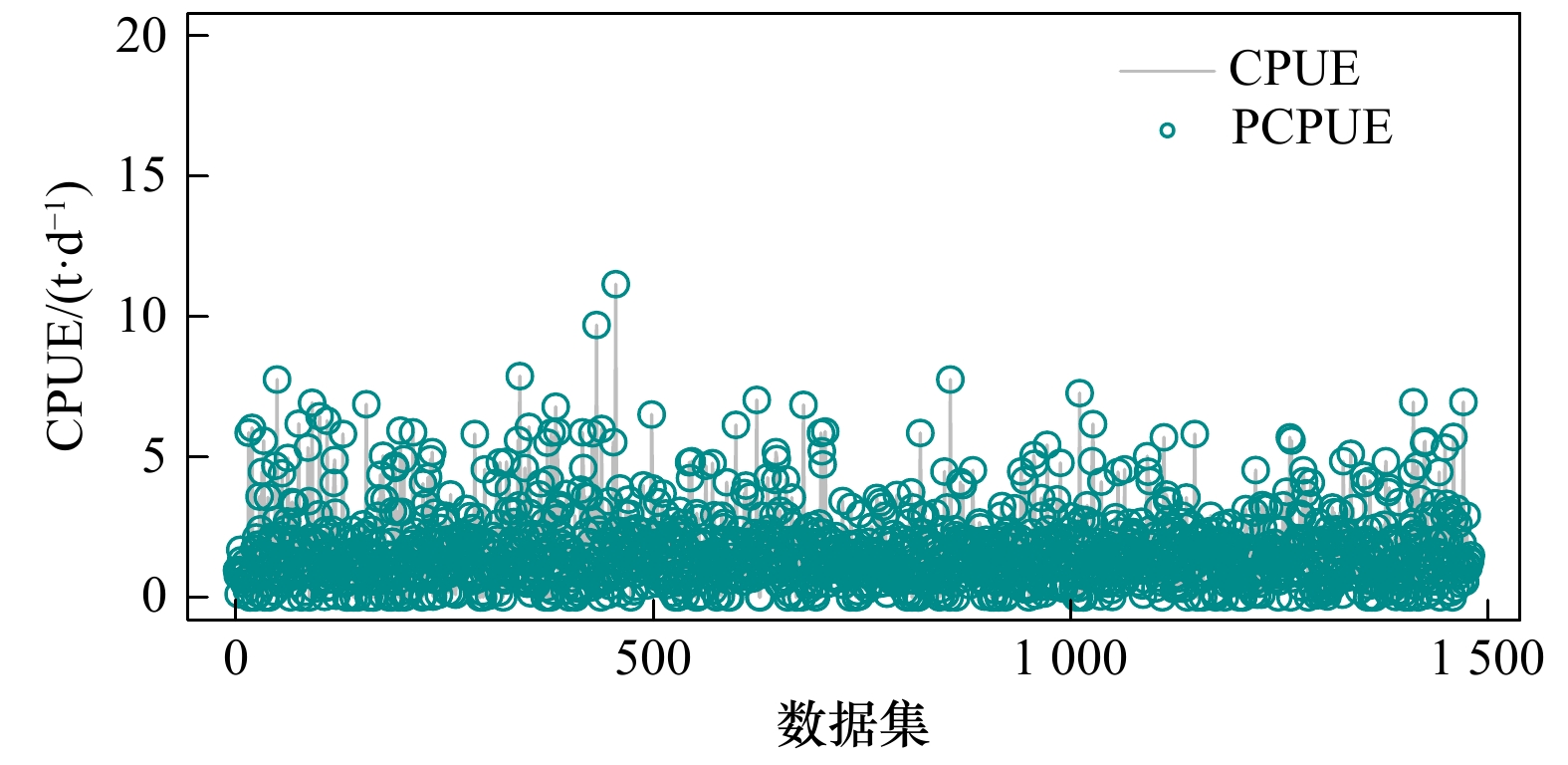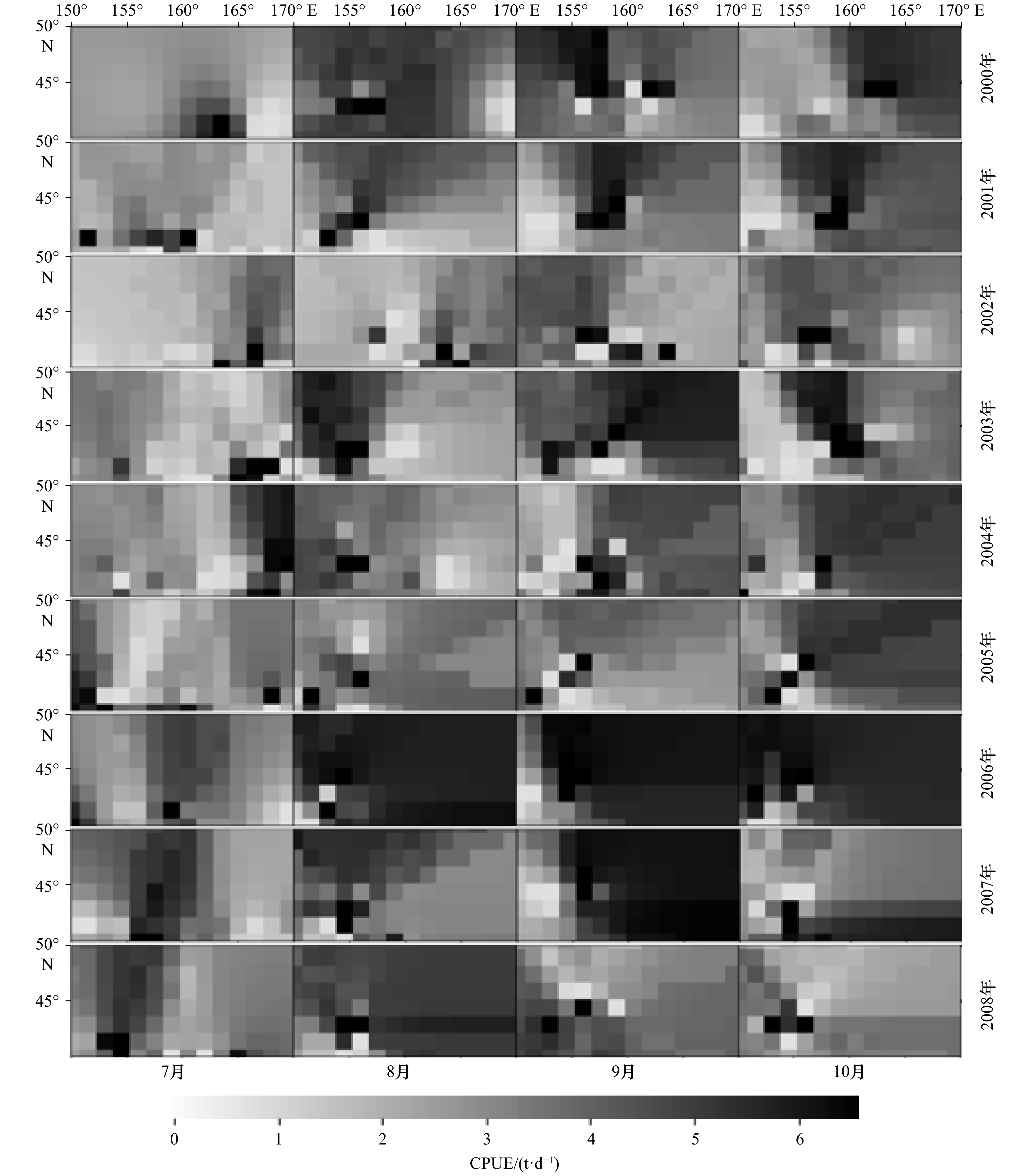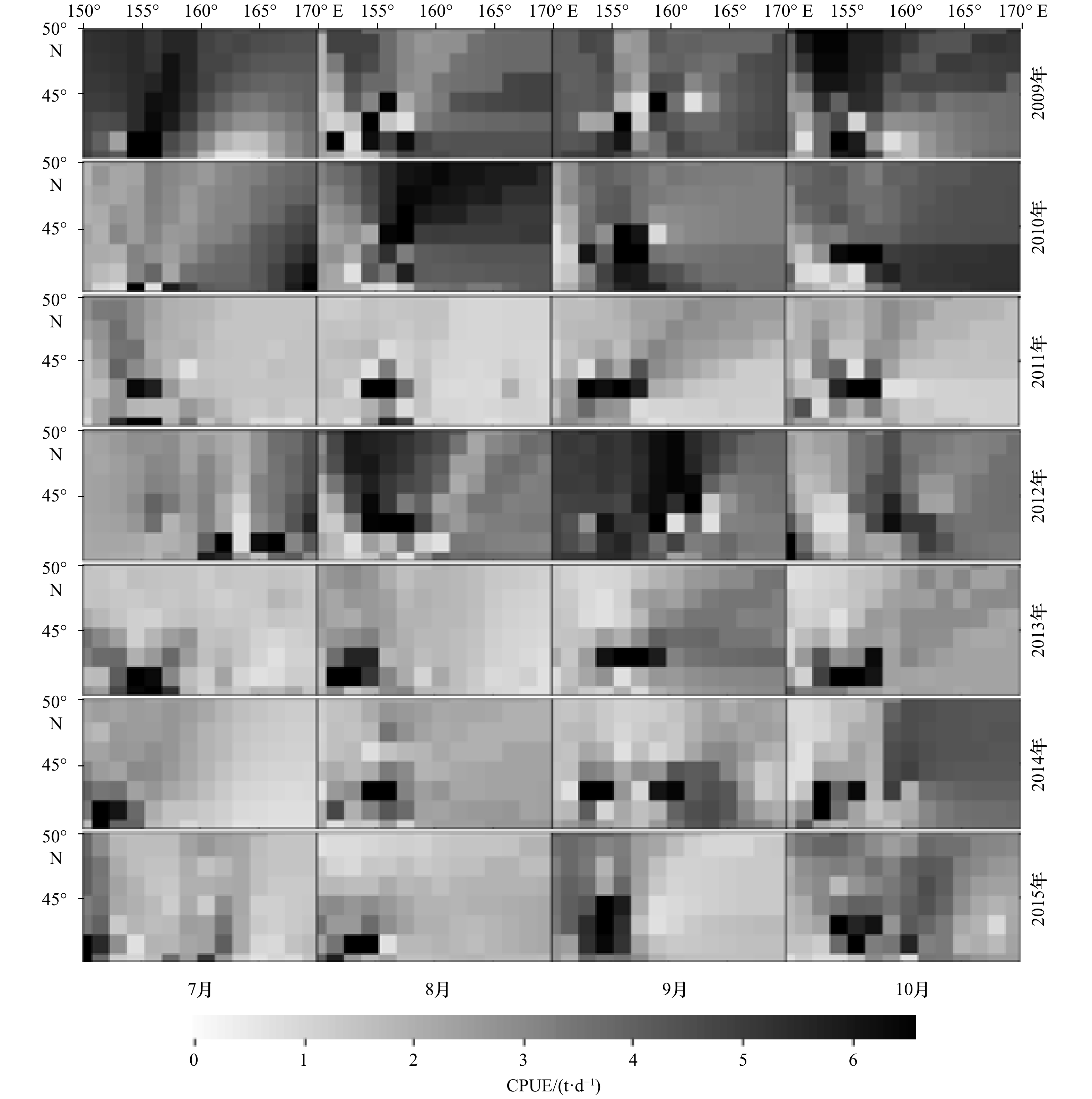Spatio-temporal dynamic of abundance index of Neon flying squid in relation to environmental variables in the Northwest Pacific Ocean using BP neural network
-
摘要: 西北太平洋柔鱼(Ommastrephes bartramii)是我国鱿钓船队重要捕捞对象,其资源分布的时空变化对资源的可持续开发和利用有重要影响。本文以2000−2015年7−10月西北太平洋柔鱼渔业数据的单位捕捞努力量渔获量作为应变量,以年份、月份、经度、纬度、海表面温度、海表盐度、海面高度、叶绿素a浓度作为自变量,构建BP神经网络模型,推测该段时间西北太平洋柔鱼丰度时空变化规律,并探究环境因子对柔鱼资源丰度的影响。通过比较,确定输入层为年份、月份、经度、纬度、海表面温度和海表盐度,隐含层神经元数量为8的模型均方误差最小,模型最优。结果表明,单位捕捞努力量渔获量年间波动明显,每年的7月、10月柔鱼资源丰度较低,且空间分布分散在整个作业渔场,8月、9月资源丰度较高,并集中在41.5°~43.5°N, 155°~160°E局部区域。研究认为,海表面温度和海表盐度对柔鱼资源丰度时空变动有较大影响,在今后柔鱼资源评估与管理中予以考虑。Abstract: Ommastrephes bartramii is an economically important species for Chinese squid jigging fleet. Understanding the spatio-temporal distribution on fishing ground is crucial to the sustainable utilization of fish resources. The study constructed BP (back propagation) neural network models with different scenarios to speculate the dynamics of O. bartramii abundance based on fishery data in the months of July to October during 2000 to 2015. The model with year, month, longitude, latitude, sea surface temperature (SST), and sea surface salinity (SSS) as independent variables, 8 neurons in hidden layers, had the smallest mean square error, and thus selected as optimal model. The results showed that the significant fluctuation in CPUE between years, the local abundance was low and scattered in July and October, whereas was high and concentrated at 41.5°−43.5°N, 155°−160°E in August and September. Environmental factors, including SST and SSS affect the spatio-temporal distribution of local abundance, and should be considered in stock assessment and management.
-
表 1 西北太平洋柔鱼空间分布BP神经网络模型
Tab. 1 Spatial BP neural network models for Ommastrephes bartramii in the Northwest Pacific Ocean
方案 输入层因子 BP神经网络模型结构 1 经度、纬度、年份、月份、SST 5-4-1、5-5-1、5-6-1、5-7-1、5-8-1、
5-9-1、5-10-1、5-11-1、5-12-12 经度、纬度、年份、月份、SST、SSS 6-4-1、6-5-1、6-6-1、6-7-1、6-8-1、
6-9-1、6-10-1、6-11-1、6-12-13 经度、纬度、年份、月份、SST、SSS、Chl a浓度 7-4-1、7-5-1、7-6-1、7-7-1、7-8-1、
7-9-1、7-10-1、7-11-1、7-12-14 经度、纬度、年份、月份、SST、SSS、Chl a浓度、SSH 8-4-1、8-5-1、8-6-1、8-7-1、8-8-1、8-9-1、8-10-1、8-11-1、8-12-1、8-13-1 注:BP神经网络模型结构中数字分别表示输入层、隐含层和输出层神经元个数。 表 2 不同方案不同隐含层下训练集CPUE的均方误差
Tab. 2 Mean square error of training dataset CPUE for different scenarios
隐含层数 方案 1 2 3 4 4 0.042 1 0.041 7 0.043 6 0.045 3 5 0.041 6 0.040 9 0.043 1 0.044 5 6 0.041 0 0.039 5 0.042 5 0.043 8 7 0.040 2 0.038 8 0.042 1 0.043 5 8 0.039 4 0.038 2 0.041 9 0.042 9 9 0.038 9 0.038 4 0.041 7 0.042 6 10 0.039 2 0.038 6 0.041 9 0.043 0 11 0.040 4 0.039 2 0.042 4 0.043 2 12 0.041 3 0.041 5 0.042 9 0.043 8 13 0.041 7 0.042 0 0.043 2 0.044 5 表 3 不同方案不同隐含层下测试集CPUE的均方误差
Tab. 3 Mean square error of testing dataset CPUE for different scenarios
隐含层数 方案 1 2 3 4 4 0.041 8 0.041 3 0.043 3 0.044 7 5 0.041 3 0.040 7 0.042 8 0.044 0 6 0.040 6 0.039 2 0.042 2 0.043 4 7 0.039 9 0.038 6 0.041 9 0.043 1 8 0.039 2 0.038 0 0.041 6 0.042 6 9 0.038 8 0.038 3 0.041 4 0.042 3 10 0.039 0 0.038 4 0.041 6 0.042 7 11 0.040 0 0.038 8 0.042 1 0.042 9 12 0.041 1 0.040 7 0.042 7 0.043 3 13 0.041 5 0.041 6 0.043 0 0.044 0 -
[1] 余为, 陈新军, 易倩, 等. 北太平洋柔鱼早期生活史研究进展[J]. 上海海洋大学学报, 2013, 22(5): 755−756.Yu Wei, Chen Xinjun, Yi Qian, et al. Review on the early life history of neon flying squid (Ommastrephes bartramii) in the North Pacific[J]. Journal of Shanghai Ocean University, 2013, 22(5): 755−756. [2] 陈新军, 王尧耕. 中国远洋鱿钓渔业的发展前景[J]. 中国渔业经济研究, 1999(2): 38−39.Chen Xinjun, Wang Yaogeng. The future of high sea squid angling fishery of China[J]. Chinese Fisheries Economy Research, 1999(2): 38−39. [3] 陈新军. 世界头足类资源开发现状及我国远洋鱿钓渔业发展对策[J]. 上海海洋大学学报, 2019, 28(3): 321−330.Chen Xinjun. Development status of world cephalopod fisheries and suggestions for squid jigging fishery in China[J]. Journal of Shanghai Ocean University, 2019, 28(3): 321−330. [4] Murata M. Oceanic resources of squids[J]. Marine Behaviour and Physiology, 1990, 18(1): 19−71. doi: 10.1080/10236249009378779 [5] 魏广恩, 陈新军. 北太平洋柔鱼(Ommastrephes bartramii)资源渔场研究进展[J]. 广东海洋大学学报, 2016, 36(6): 114−122. doi: 10.3969/j.issn.1673-9159.2016.06.018Wei Guang’en, Chen Xinjun. Review on neon flying squid (Ommastrephes bartramii) resources and fishing ground in the North Pacific Ocean[J]. Journal of Guangdong Ocean University, 2016, 36(6): 114−122. doi: 10.3969/j.issn.1673-9159.2016.06.018 [6] Chen C S, Chiu T S. Abundance and spatial variation of Ommastrephes bartramii (Mollusca: Cephalopoda) in the Eastern North Pacific observed from an exploratory survey[J]. Acta Zoologica Taiwanica, 1999, 10(2): 135−144. [7] 雷林, 汪金涛, 陈新军, 等. 利用渔场环境因子标准化西北太平洋柔鱼CPUE的研究[J]. 海洋学报, 2019, 41(1): 134−141.Lei Lin, Wang Jintao, Chen Xinjun, et al. Standardizing CPUE of Ommastrephes bartramii in the Northwest Pacific Ocean based on environmental factors of habitat[J]. Haiyang Xuebao, 2019, 41(1): 134−141. [8] 余为, 陈新军. 西北太平洋柔鱼栖息地环境因子分析及其对资源丰度的影响[J]. 生态学报, 2015, 35(15): 5032−5039.Yu Wei, Chen Xinjun. Analysis of environmental conditions and their influence on the abundance of neon flying squid in the Northwest Pacific Ocean[J]. Acta Ecologica Sinica, 2015, 35(15): 5032−5039. [9] 温健, 陆鑫一, 陈新军, 等. 基于海表温度和光合有效辐射的西北太平洋柔鱼冬春生群体栖息地热点预测[J]. 上海海洋大学学报, 2019, 28(3): 456−463.Wen Jian, Lu Xinyi, Chen Xinjun, et al. Predicting the habitat hot spots of winter-spring cohort of Ommastrephes bartramii in the northwest Pacific Ocean based on the sea surface temperature and photosynthetically active radiation[J]. Journal of Shanghai Ocean University, 2019, 28(3): 456−463. [10] 崔雪森, 周为峰, 唐峰华, 等. 基于约束线性回归的柔鱼栖息地指数渔场预报模型构建[J]. 渔业科学进展, 2018, 39(1): 64−72. doi: 10.11758/yykxjz.20161207002Cui Xuesen, Zhou Weifeng, Tang Fenghua, et al. The construction of habitat suitability index forecast model of Ommastrephes bartramii fishing ground based on constrained linear regression[J]. Progress in Fishery Sciences, 2018, 39(1): 64−72. doi: 10.11758/yykxjz.20161207002 [11] 高峰, 陈新军, 范江涛, 等. 西南大西洋阿根廷滑柔鱼中心渔场预报的实现及验证[J]. 上海海洋大学学报, 2011, 20(5): 754−758.Gao Feng, Chen Xinjun, Fan Jiangtao, et al. Implementation and verification of intelligent fishing ground forecasting of Illex argentinus in the Southwest Atlantic[J]. Journal of Shanghai Ocean University, 2011, 20(5): 754−758. [12] 陈新军, 陆化杰, 刘必林, 等. 利用栖息地指数预测西南大西洋阿根廷滑柔鱼渔场[J]. 上海海洋大学学报, 2012, 21(3): 431−438.Chen Xinjun, Lu Huajie, Liu Bilin, et al. Forecasting fishing ground of Illex argentinus by using habitat suitability model in the southwest Atlantic[J]. Journal of Shanghai Ocean University, 2012, 21(3): 431−438. [13] Mantua N J, Hare S R. The Pacific Decadal Oscillation[J]. Journal of Oceanography, 2002, 58: 35−44. doi: 10.1023/A:1015820616384 [14] Yu Wei, Chen Xinjun, Yi Qian, et al. A review of interaction between neon flying squid (Ommastrephes bartramii) and oceanographic variability in the North Pacific Ocean[J]. Journal of Ocean University of China, 2015, 14(4): 739−748. doi: 10.1007/s11802-015-2562-8 [15] Wang Wenyu, Zhou Chenghu, Shao Quanqin, et al. Remote sensing of sea surface temperature and chlorophyll-a: implications for squid fisheries in the north-west Pacific Ocean[J]. International Journal of Remote Sensing, 2010, 31(17/18): 4515−4530. [16] 余为, 陈新军, 易倩. 不同气候模态下西北太平洋柔鱼渔场环境特征分析[J]. 水产学报, 2017, 41(4): 525−534.Yu Wei, Chen Xinjun, Yi Qian. Analysis of variations in the environmental conditions on the fishing ground of neon flying squid (Ommastrphes bartramii) in the Northwestern Pacific Ocean under different climate modes[J]. Journal of Fisheries of China, 2017, 41(4): 525−534. [17] 魏广恩. 北太平洋柔鱼渔场的时空分析与资源丰度的预测[D]. 上海: 上海海洋大学, 2018.Wen Guang’en. Ommastrphes bartramii fishing ground and its resource abundance prediction in the North Pacific Ocean[D]. Shanghai: Shanghai Ocean University, 2018. [18] 高雪, 陈新军, 余为. 基于灰色系统的西北太平洋柔鱼冬春生群资源丰度预测模型[J]. 海洋学报, 2017, 39(6): 55−61.Gao Xue, Chen Xinjun, Yu Wei. Forecasting model of the abundance index of winter-spring cohort of neon flying squid (Ommastrephes bartramii) in the Northwest Pacific Ocean based on grey system theory[J]. Haiyang Xuebao, 2017, 39(6): 55−61. [19] 汪金涛, 陈新军, 雷林, 等. 基于频度统计和神经网络的北太平洋柔鱼渔场预报模型比较[J]. 广东海洋大学学报, 2014, 34(3): 82−87. doi: 10.3969/j.issn.1673-9159.2014.03.015Wang Jintao, Chen Xinjun, Lei Lin, et al. Comparisons between two forecasting models of fishing ground based on frequency statistics and neural network for Ommastrephes bartramii in the North Pacific Ocean[J]. Journal of Guangdong Ocean University, 2014, 34(3): 82−87. doi: 10.3969/j.issn.1673-9159.2014.03.015 [20] Bashir Z A, El-Hawary M E. Applying wavelets to short-term load forecasting using PSO-based neural networks[J]. IEEE Transactions on Power Systems, 2009, 24(1): 20−27. doi: 10.1109/TPWRS.2008.2008606 [21] 徐富强, 钱云, 刘相国. GA-BP神经网络的非线性函数拟合[J]. 微机算计信息, 2012, 28(7): 148−149, 145.Xu Fuqiang, Qian Yun, Liu Xiangguo. GA-BP neural network of the nonlinear function approximating[J]. Control & Automation, 2012, 28(7): 148−149, 145. [22] 林宇锋, 邓洪敏, 史兴宇. 基于新的改进粒子群算法的BP神经网络在拟合非线性函数中的应用[J]. 计算机科学, 2017, 44(11A): 51−54. doi: 10.11896/j.issn.1002-137X.2017.11A.009Lin Yufeng, Deng Hongmin, Shi Xingyu. Application of BP neural network based on newly improved particle swarm optimization algorithm in fitting nonlinear function[J]. Computer Science, 2017, 44(11A): 51−54. doi: 10.11896/j.issn.1002-137X.2017.11A.009 [23] 何伟, 谭骏珊, 王楚正, 等. BP神经网络的改进算法及应用[J]. 信息与电脑, 2009(10): 56−57.He Wei, Tan Junshan, Wang Chuzheng, et al. Improved algorithm and application of BP neural network[J]. China Computer & Communication, 2009(10): 56−57. [24] 汪金涛, 高峰, 雷林, 等. 基于主成分和BP神经网络的智利竹筴鱼渔场预报模型研究[J]. 海洋学报, 2014, 36(8): 65−71.Wang Jintao, Gao Feng, Lei Lin, et al. Application of BP neural network based on principal component analysis in fishing grounds of Chilean jack mackerel (Trachurus murphyi) in the southeast Pacific Ocean[J]. Haiyang Xuebao, 2014, 36(8): 65−71. [25] 刘刚. 一种综合改进的BP神经网络及其实现[J]. 武汉理工大学学报, 2002, 24(10): 57−60. doi: 10.3321/j.issn:1671-4431.2002.10.017Liu Gang. A kind of comprehensively improved BP neural network and its realization[J]. Journal of Wuhan University of Technology, 2002, 24(10): 57−60. doi: 10.3321/j.issn:1671-4431.2002.10.017 [26] 耿烜, 孙作雷, 刘锋, 等. 基于块对角化的最小均方误差矢量预编码[J]. 上海交通大学学报, 2014, 48(10): 1410−1414, 1420.Geng Xuan, Sun Zuolei, Liu Feng, et al. Minimum mean square error vector precoding based on block diagonalization[J]. Journal of Shanghai Jiao Tong University, 2014, 48(10): 1410−1414, 1420. [27] Alabia I D, Saitoh S I, Mugo R, et al. Seasonal potential fishing ground prediction of neon flying squid (Ommastrephes bartramii) in the western and central North Pacific[J]. Fisheries Oceanography, 2015, 24(2): 190−203. doi: 10.1111/fog.12102 [28] 魏广恩. 北太平洋柔鱼渔场的时空分析与资源丰度的预测[D]. 上海: 上海海洋大学, 2018.Wei Guang’en. Spatial and temporal analysis of Ommastrphes bartramii fishing ground and its resource abundance prediction in the North Pacific Ocean[D]. Shanghai: Shanghai Ocean University, 2018. [29] 范江涛, 陈新军, 曹杰, 等. 西北太平洋柔鱼渔场变化与黑潮的关系[J]. 上海海洋大学学报, 2010, 19(3): 378−384.Fan Jiangtao, Chen Xinjun, Cao Jie, et al. The variation of fishing ground of Ommastrephes bartramii in the Northwest Pacific concerning with Kuroshio current[J]. Journal of Shanghai Ocean University, 2010, 19(3): 378−384. [30] 余为, 陈新军, 易倩, 等. 西北太平洋柔鱼传统作业渔场资源丰度年间差异及其影响因子[J]. 海洋渔业, 2013, 35(4): 373−381. doi: 10.3969/j.issn.1004-2490.2013.04.001Yu Wei, Chen Xinjun, Yi Qian, et al. Annual difference of abundance index and its influencing factors of Ommastrephes bartramii in traditional fishing grounds in the Northwest Pacific[J]. Marine Fisheries, 2013, 35(4): 373−381. doi: 10.3969/j.issn.1004-2490.2013.04.001 [31] 陈芃, 陈新军. 基于最大熵模型分析西南大西洋阿根廷滑柔鱼栖息地分布[J]. 水产学报, 2016, 40(6): 893−902.Chen Peng, Chen Xinjun. Analysis of habitat distribution of Argentine shortfin squid (Illex argentinus) in the southwest Atlantic Ocean using maximum entropy model[J]. Journal of Fisheries of China, 2016, 40(6): 893−902. [32] 沈建华, 韩士鑫, 崔雪森, 等. 北太平洋巴特柔鱼渔业2001年低产原因分析[J]. 水产学报, 2013, 27(4): 350−357.Shen Jianhua, Han Shixin, Cui Xuesen, et al. An explanation on poorer harvest of flying squid in the North Pacific in 2001[J]. Journal of Fisheries of China, 2013, 27(4): 350−357. [33] Murata M, Nakamura Y. Seasonal migration and diel vertical migration of the neon flying squid, Ommastrephes bartramii in the North Pacific[J]. Japan Marine Fishery Resources Center, Tokyo, 1998, 25: 13−30. [34] Litz M N C, Phillips A J, Brodeur R D, et al. Seasonal occurrences of Humboldt squid (Dosidicus gigas) in the northern California Current System[J]. California Cooperative Oceanic Fisheries Investigations Report, 2011, 52: 97−108. [35] 官文江, 田思泉, 王学昉, 等. CPUE标准化方法与模型选择的回顾与展望[J]. 中国水产科学, 2014, 21(4): 852−862.Guan Wenjiang, Tian Siquan, Wang Xuefang, et al. A review of methods and model selection for standardizing CPUE[J]. Journal of Fishery Sciences of China, 2014, 21(4): 852−862. [36] Maunder M N, Hinton M G. Estimating relative abundance from catch and effort data, using neural networks[R]. La Jolla, California: Inter-American Tropical Tuna Commission Comisión Ineramericana Del Atún Tropical, 2006. [37] 田思泉, 陈新军. 不同名义CPUE计算法对CPUE标准化的影响[J]. 上海海洋大学学报, 2010, 19(2): 240−245.Tian Siquan, Chen Xinjun. Impacts of different calculating methods for nominal CPUE on CPUE standardization[J]. Journal of Shanghai Ocean University, 2010, 19(2): 240−245. [38] 武美先, 张学良, 温淑花, 等. BP神经网络及其改进[J]. 太原科技大学学报, 2005, 26(2): 120−125, 130. doi: 10.3969/j.issn.1673-2057.2005.02.011Wu Meixian, Zhang Xueliang, Wen Shuhua, et al. Summarization of BP neural network’s improvement[J]. Journal of Taiyuan University of Science and Technology, 2005, 26(2): 120−125, 130. doi: 10.3969/j.issn.1673-2057.2005.02.011 -





 下载:
下载:






